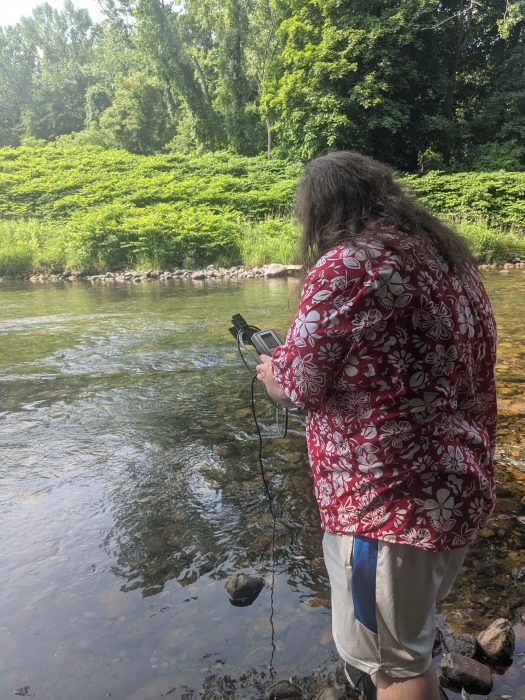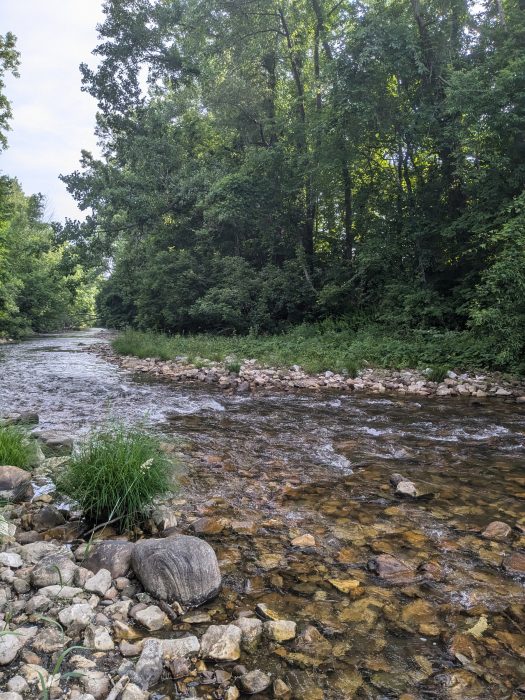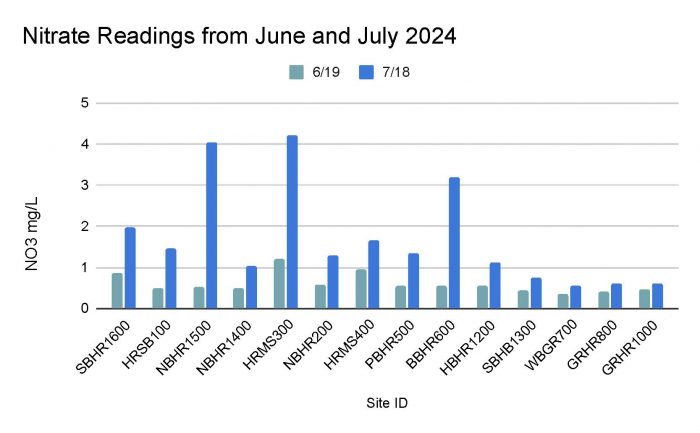
Jakob, one of HooRWA’s summer interns using the nitrate monitor.
HooRWA has recently acquired a Nitrate monitor that we are using once a month at 14 sites across Clarksburg, Adams, North Adams, and Williamstown. Unlike lab analysis of Nitrate, this monitor allows us to get results immediately in the field.
Nitrate(NO3) is a molecule composed of one nitrogen atom and three oxygen atoms. It occurs naturally within ecosystems, due to various factors, including animal waste and plant decomposition or respiration; however, nitrate levels within ecosystems can become increased by human factors, such as fertilizer use. Nitrate is vital to aquatic ecosystems, as plants need it to grow and survive, although high levels of nitrate may be reason for concern.
If consumed, nitrate will convert to nitrite (NO2) in the human body, which compromises the body’s ability to carry oxygen in the bloodstream. This can lead to several adverse health effects, especially for young children or people who are pregnant. A common illness connected to excess nitrate is referred to as Blue Baby Syndrome. These problems, however, should not be cause for worry unless you are drinking water with high levels of nitrate or nitrite.
The monitor that HooRWA uses reads levels of nitrate in parts per million or milligrams per liter. Per the EPA, the maximum contaminant level of nitrate is 10 mg/L. Levels under 1 are ideal, although you should not be concerned so long as levels remain under 10 mg/L. For nitrite, the limit is 1 mg/L.
 So far, all sites that HooRWA has sampled have been under the threshold of 10 mg/L. We have seen readings as high as 4.2 mg/L, but that has been well below the concern level, and this is likely due to the increased rains from the night before, as this location had previously shown 1.21 mg/L. While HooRWA does not currently test for nitrite, it is unlikely that any locations would exceed the 1 mg/L limit based on the readings of nitrate.
So far, all sites that HooRWA has sampled have been under the threshold of 10 mg/L. We have seen readings as high as 4.2 mg/L, but that has been well below the concern level, and this is likely due to the increased rains from the night before, as this location had previously shown 1.21 mg/L. While HooRWA does not currently test for nitrite, it is unlikely that any locations would exceed the 1 mg/L limit based on the readings of nitrate.
Some studies have found health impacts in Trout when nitrate levels become high; however, these studies have focused on levels that are as high as 80-100 mg/L. Right now, nitrate levels in the Hoosic are not concerning for either fish or humans, but it is extremely important to keep an eye on nitrate. Because this area has many farms along the waterways, there is a potential risk for increased nitrate levels after heavy rains or flooding, which may eventually affect wildlife. Until then, however, HooRWA will continue to do nitrate testing to ensure that if that level is hit, we are among the first to know.
Below is a graph depicting the results that we have gathered so far, with a brief description of each location.

Site Descriptions:
- SBHR1600: Downstream of an industrial park and farm; upstream of the Adams Wastewater Treatment Plant
- HRSB100: small stream located next to a recreational area off of Route 8; upstream of confluence with the Hoosic River South Branch
- NBHR1500: at the confluence of Hudson Brook with the Hoosic River North Branch, before the Beaver Mill Dam at the bottom of the Natural Bridge State Park
- NBHR1400: Downstream of a farm, right before the Vermont border in Clarksburg
- HRMS300: Downstream of the North Adams Flood Chutes where the South and North branches of the Hoosic Meet
- NBHR200: Notch Brook along Brayton Ave, before the confluence with the Hoosic Main Stem
- HRMS400: Ashton Avenue public canoe launch location
- PBHR500: Paull Brook, which travels from the Mount Williams Reservoir; this location is at the Spruces Park, right before the confluence with the Hoosic River
- BBHR600*: Broad Brook in North Williamstown; north of the Williamstown Transfer Station
- HBHR1200: Hemlock Brook, along the side of route 7/2 bridge
- SBHB1300: Sweet Brook right before it meets with Hemlock Brook
- WBGR700: The West Branch of the Green River, right next to the 5 Corners intersection
- GRHR800: The Green River and downstream of several farms
- GRHR1000: The Green River at Linear Link Park and near the unofficial swimming hole
*Locations slightly differ between testing
Submitted by Zee Taylor, Williams College student & HooRWA Summer Intern
Resources
- Nitrate in Drinking Water by the Washington State Department of Health
- Nitrates In Drinking Water by the Illinois Department of Public Health
- Comparing the effects of high vs. low nitrate on the health, performance, and welfare of juvenile rainbow trout Oncorhynchus mykiss within water recirculating aquaculture systems by Science Direct